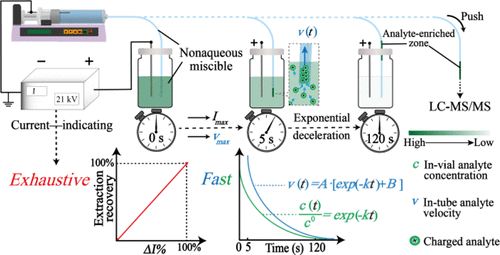当前位置:
X-MOL 学术
›
Anal. Chem.
›
论文详情
Our official English website, www.x-mol.net, welcomes your
feedback! (Note: you will need to create a separate account there.)
Nonaqueous Miscible Liquid–Liquid Electroextraction for Fast Exhaustive Enrichment of Ultratrace Analytes by an Exponential Transfer and Deceleration Mechanism
Analytical Chemistry ( IF 6.7 ) Pub Date : 2020-12-29 , DOI: 10.1021/acs.analchem.0c03478 Jiahao Yuan 1 , Hongjie Cao 1 , Xiaotong Du 1 , Tengteng Chen 1 , Ande Ma 1 , Jialiang Pan 1
Analytical Chemistry ( IF 6.7 ) Pub Date : 2020-12-29 , DOI: 10.1021/acs.analchem.0c03478 Jiahao Yuan 1 , Hongjie Cao 1 , Xiaotong Du 1 , Tengteng Chen 1 , Ande Ma 1 , Jialiang Pan 1
Affiliation

|
Conventional electrical-field-assisted sample preparation (EFASP) methods rely on analyte transfer between immiscible phases and require at least one aqueous phase in contact with the electrode. In this paper, we report a novel nonaqueous miscible liquid–liquid electroextraction (NMLEE) technique that enables fast exhaustive enrichment of ultratrace analytes from a milliliter-level donor in a vial to a microliter-level acceptor in a tube. Miscible nonaqueous solvents are used for the donor and acceptor to overcome common EFASP problems such as high charge or mass transfer resistance, loss of analytes in the membrane phase, water electrolysis, back-extraction, bubble generation, and difficulties in the application of high voltage for fast migration. According to theoretical derivation and experimental verification results, the concentrations of analytes in the donor and their migration velocity in the acceptor both decrease exponentially with time, and the extraction recovery correlates linearly with the current variation. These mechanisms result in efficient enrichment by forming an analyte-enriched zone and allow the extraction progress and recovery to be monitored and estimated based on the current variation. NMLEE was coupled with liquid chromatography–mass spectrometry to analyze 10 amphetamine-type drugs, atropine, nortriptyline, and methadone in blood and urine samples. This method provided low limits of detection (0.003–0.1 ng·mL–1), satisfactory extraction recoveries (89.6–104.1%), and RSDs (<12.3% for intraday and <8.8% for interday), which met the requirements of the ICH guidelines. This study may contribute to the further development of EFASP methods for effective ultratrace analyses in forensic science.
中文翻译:

非水溶混液电萃取通过指数转移和减速机理快速富集超痕量分析物
常规的电场辅助样品制备(EFASP)方法依赖于不混溶相之间的分析物转移,并且需要至少一种水相与电极接触。在本文中,我们报告了一种新颖的非水混溶液-液电萃取(NMLEE)技术,该技术能够从小瓶中的毫升级供体到管中的微升级受体快速富集富集超痕量分析物。混合的非水溶剂用于供体和受体,以克服常见的EFASP问题,例如高电荷或传质阻力,膜相中分析物的损失,水电解,反萃取,气泡生成以及施加高压的困难快速迁移。根据理论推导和实验验证结果,供体中分析物的浓度及其在受体中的迁移速度均随时间呈指数下降,提取回收率与电流变化呈线性相关。这些机制通过形成富集分析物的区域而导致有效富集,并允许根据电流变化对提取过程和回收率进行监控和估算。NMLEE与液相色谱-质谱联用,可分析血液和尿液样本中的10种苯丙胺类药物,阿托品,去甲替林和美沙酮。该方法提供了低检测限(0.003–0.1 ng·mL 这些机制通过形成富集分析物的区域而导致有效富集,并允许根据电流变化对提取过程和回收率进行监控和估算。NMLEE与液相色谱-质谱联用,可分析血液和尿液样本中的10种苯丙胺类药物,阿托品,去甲替林和美沙酮。该方法提供了低检测限(0.003–0.1 ng·mL 这些机制通过形成富集分析物的区域而导致有效富集,并允许根据电流变化对提取过程和回收率进行监控和估算。NMLEE与液相色谱-质谱联用,可分析血液和尿液样本中的10种苯丙胺类药物,阿托品,去甲替林和美沙酮。该方法提供了低检测限(0.003–0.1 ng·mL–1),令人满意的提取回收率(89.6–104.1%)和RSD(日间<12.3%,日间<8.8%),均符合ICH指南的要求。这项研究可能有助于进一步发展法医学用于有效超痕量分析的EFASP方法。
更新日期:2021-01-26
中文翻译:

非水溶混液电萃取通过指数转移和减速机理快速富集超痕量分析物
常规的电场辅助样品制备(EFASP)方法依赖于不混溶相之间的分析物转移,并且需要至少一种水相与电极接触。在本文中,我们报告了一种新颖的非水混溶液-液电萃取(NMLEE)技术,该技术能够从小瓶中的毫升级供体到管中的微升级受体快速富集富集超痕量分析物。混合的非水溶剂用于供体和受体,以克服常见的EFASP问题,例如高电荷或传质阻力,膜相中分析物的损失,水电解,反萃取,气泡生成以及施加高压的困难快速迁移。根据理论推导和实验验证结果,供体中分析物的浓度及其在受体中的迁移速度均随时间呈指数下降,提取回收率与电流变化呈线性相关。这些机制通过形成富集分析物的区域而导致有效富集,并允许根据电流变化对提取过程和回收率进行监控和估算。NMLEE与液相色谱-质谱联用,可分析血液和尿液样本中的10种苯丙胺类药物,阿托品,去甲替林和美沙酮。该方法提供了低检测限(0.003–0.1 ng·mL 这些机制通过形成富集分析物的区域而导致有效富集,并允许根据电流变化对提取过程和回收率进行监控和估算。NMLEE与液相色谱-质谱联用,可分析血液和尿液样本中的10种苯丙胺类药物,阿托品,去甲替林和美沙酮。该方法提供了低检测限(0.003–0.1 ng·mL 这些机制通过形成富集分析物的区域而导致有效富集,并允许根据电流变化对提取过程和回收率进行监控和估算。NMLEE与液相色谱-质谱联用,可分析血液和尿液样本中的10种苯丙胺类药物,阿托品,去甲替林和美沙酮。该方法提供了低检测限(0.003–0.1 ng·mL–1),令人满意的提取回收率(89.6–104.1%)和RSD(日间<12.3%,日间<8.8%),均符合ICH指南的要求。这项研究可能有助于进一步发展法医学用于有效超痕量分析的EFASP方法。











































 京公网安备 11010802027423号
京公网安备 11010802027423号